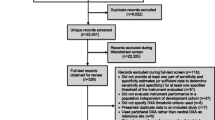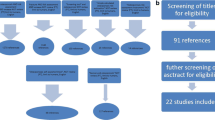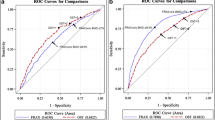Abstract
Summary
The Osteoporosis Self-Assessment Tool (OST) is a simple test that may be of clinical value to rule-out low bone mineral density. We performed a systematic review to assess its performance in postmenopausal women. We included 36 studies. OST performed moderately in ruling-out femoral neck T-score ≤ −2.5, but poorly in ruling-out lumbar spine T-score ≤ −2.5. Methodological study quality was generally low.
Introduction
The Osteoporosis Self-Assessment Tool (OST) is a simple clinical decision rule based on age and weight that may be of clinical value to rule-out low bone mineral density (BMD). Our aim was to systematically assess the performance of OST in postmenopausal women.
Methods
We searched PubMed, Embase, Web of Science, citation lists and conference proceedings for studies evaluating OST using dual X-ray absorptiometry (DXA) as reference test to measure BMD. We evaluated methodological quality using the QUADAS checklist. Our main outcome was the likelihood ratio of a negative OST result (LR-).
Results
OST performed moderately in ruling-out femoral neck T-score ≤ −2.5 in whites, summary LR- (sLR-) 0.19 (95% CI, 0.17–0.21) and between-study heterogeneity was low (I 2 = 7%). The corresponding performance in Asians was similar, sLR- 0.19 (0.14–0.28), but there was considerable heterogeneity (I 2 = 64%). OST performed poorly in ruling-out lumbar spine T-score ≤ −2.5 in whites and Asians, sLR- 0.43 (0.31–0.59) and 0.32 (0.28–0.38), respectively. The performance in ruling-out T-score ≤ −2.0 in whites was poor regardless of region (sLR- ≥0.28). Methodological study quality was generally low.
Conclusions
The clinical usefulness of OST is uncertain. OST could be useful for ruling-out femoral neck T-score ≤ −2.5, but confirmatory high-quality studies are needed.




Similar content being viewed by others
References
Black DM, Thompson DE, Bauer DC et al (2000) Fracture risk reduction with alendronate in women with osteoporosis: the Fracture Intervention Trial. J Clin Endocrinol Metab 85:4118–4124
Chesnut III CH, Skag A, Christiansen C et al (2004) Effects of oral ibandronate administered daily or intermittently on fracture risk in postmenopausal osteoporosis. J Bone Miner Res 19:1241–1249
Ettinger B, Black DM, Mitlak BH et al (1999) Reduction of vertebral fracture risk in postmenopausal women with osteoporosis treated with raloxifene: results from a 3-year randomized clinical trial. JAMA 282:637–645
Harris ST, Watts NB, Genant HK et al (1999) Effects of risedronate treatment on vertebral and nonvertebral fractures in women with postmenopausal osteoporosis: a randomized controlled trial. JAMA 282:1344–1352
McClung MR, Geusens P, Miller PD et al (2001) Effect of risedronate on the risk of hip fracture in elderly women. N Engl J Med 344:333–340
Reginster JY, Seeman E, De Vernejoul MC et al (2005) Strontium ranelate reduces the risk of nonvertebral fractures in postmenopausal women with osteoporosis. J Clin Endocrinol Metab 90:2816–2822
Kanis JA (2002) Diagnosis of osteoporosis and assessment of fracture risk. Lancet 359:1929–1936
Nelson HD, Helfand M, Woolf SH et al (2002) Screening for postmenopausal osteoporosis: a review of the evidence for the U.S. Preventive Services Task Force. Ann Intern Med 137:529–541
Morris CA, Cabral D, Cheng H et al (2004) Patterns of bone mineral testing. Current guidelines, testing rates, and interventions. J Gen Intern Med 19:783–790
Cummings SR, Melton LJ (2002) Epidemiology and outcomes of osteoporotic fractures. Lancet 359:1761–1767
Cadarette SM, Jaglal SB, Kreiger N et al (2000) Development and validation of the Osteoporosis Risk Assessment Instrument to facilitate selection of women for bone densitometry. CMAJ 162:1289–1294
Koh LK, Sedrine WB, Torralba TP et al (2001) A simple tool to identify Asian women at increased risk of osteoporosis. Osteoporos Int 12:699–705
Lydick E, Cook K, Turpin J et al (1998) Development and validation of a simple questionnaire to facilitate identification of women likely to have low bone density. Am J Manag Care 4:37–48
Sedrine WB, Chevallier T, Zegels B et al (2002) Development and assessment of the Osteoporosis Index of Risk (OSIRIS) to facilitate selection of women for bone densitometry. Gynecol Endocrinol 16:245–250
Sen SS, Rives VP, Messina OD, Morales-Torres J et al (2005) A risk assessment tool (OsteoRisk) for identifying Latin American women with osteoporosis. J Gen Intern Med 20:245–250
Cummings SR, Bates D, Black DM (2002) Clinical use of bone densitometry: scientific review. JAMA 288:1889–1897
Assessment of fracture risk and its application to screening for postmenopausal osteoporosis. Report of a WHO study group. WHO technical report series 843. Geneva. 1994
Whiting P, Rutjes AW, Reitsma JB et al (2003) The development of QUADAS: a tool for the quality assessment of studies of diagnostic accuracy included in systematic reviews. BMC Med Res Methodol 3:25
Jaeschke R, Guyatt GH, Sackett DL (1994) Users’ guides to the medical literature III. How to use an article about a diagnostic test. B: What are the results and will they help me in caring for my patients? JAMA 271:703–707
Deeks JJ, Altman DG (2004) Diagnostic tests 4: likelihood ratios. BMJ 329:168–169
DerSimonian R, Laird N (1986) Meta-analysis in clinical trials. Control Clin Trials 7:177–188
Devillé WL, Buntinx F. Guidelines for conducting systematic reviews of studies evaluating the accuracy of diagnostic tests. In: Knottnerus A (ed) The Evidence Base of Clinical Diagnosis. 1st ed. London: BMJ Books; 2002:145–165
Higgins JP, Thompson SG, Deeks JJ et al (2003) Measuring inconsistency in meta-analyses. BMJ 327:557–560
Thompson SG, Sharp SJ (1999) Explaining heterogeneity in meta-analysis: a comparison of methods. Stat Med 18:2693–2708
Higgins JP, Thompson SG (2004) Controlling the risk of spurious findings from meta-regression. Stat Med 23:1663–1682
Deeks JJ, Macaskill P, Irwig L (2005) The performance of tests of publication bias and other sample size effects in systematic reviews of diagnostic test accuracy was assessed. J Clin Epidemiol 58:882–893
Glas AS, Lijmer JG, Prins MH et al (2003) The diagnostic odds ratio: a single indicator of test performance. J Clin Epidemiol 56:1129–1135
Moses LE, Shapiro D, Littenberg B (1993) Combining independent studies of a diagnostic test into a summary ROC curve: data-analytic approaches and some additional considerations. Stat Med 12:1293–1316
Richy F, Deceulaer F, Ethgen O et al (2004) Development and validation of the ORACLE score to predict risk of osteoporosis. Mayo Clin Proc 79:1402–1408
Cho J-J (2005) Evaluation of two screening decision rules for osteoporosis of menopause or perimenopause women in Korea [Abstract]. Osteoporos Int 13(Suppl 3):S68
Nguyen TV, Center JR, Pocock NA et al (2004) Limited utility of clinical indices for the prediction of symptomatic fracture risk in postmenopausal women. Osteoporos Int 15:49–55
Lu CY, Cai YH, Wei SQ (2005) Concordance rate of Osteoporosis Self-Assessment Tool for Asians and dual energy X-ray absorptiometry in diagnosis of osteoporosis [Abstract]. Osteoporos Int 16(Suppl 3):S39
Wallace LS, Ballard JE, Holiday D et al (2004) Evaluation of decision rules for identifying low bone density in postmenopausal African-American women. J Natl Med Assoc 96:290–296
Sen SS, Geling O, Ross PD et al (2002) Validating the Osteoporosis Self-Assessment Tool in New Zealand [Abstract]. Osteoporos Int 13(Suppl 3):S38
Cook RB, Collins D, Tucker J et al (2005) Comparison of questionnaire and quantitative ultrasound techniques as screening tools for DXA. Osteoporos Int 16:1565–1575
Pongchaiyakul C, Nguyen ND, Pongchaiyakul C et al (2004) Development and validation of a new clinical risk index for prediction of osteoporosis in Thai women. J Med Assoc Thai 87:910–916
Ongphiphadhanakul B, Chanprasertyothin S, Payattikul P et al (2003) The implication of assessing a polymorphism in estrogen receptor alpha gene in the risk assessment of osteoporosis using a screening tool for osteoporosis in Asians. Osteoporos Int 14:863–867
Mossman EA, Luckey M, McClung MR (2003) The Osteoporosis Self-Assessment Tool (OST) performs differently in younger versus older postmenopausal women [Abstract]. J Bone Miner Res 18(Suppl 2):S358
Gourlay ML, Miller WC, Richy F et al (2005) Performance of osteoporosis risk assessment tools in postmenopausal women aged 45–64 years. Osteoporos Int 16:921–927
Cadarette SM, Jaglal SB, Murray et al (2001) Evaluation of decision rules for referring women for bone densitometry by dual-energy X-ray absorptiometry. JAMA 286:57–63
Fujiwara S, Masunari N, Suzuki G et al (2001) Performance of osteoporosis risk indices in a Japanese population. Ther Res Clin Exp 62:586–594
Geusens P, Hochberg MC, van der Voort DJ et al (2002) Performance of risk indices for identifying low bone density in postmenopausal women. Mayo Clin Proc 77:629–637
Richy F, Gourlay M, Ross PD et al (2004) Validation and comparative evaluation of the osteoporosis self-assessment tool (OST) in a Caucasian population from Belgium. QJM 97:39–46
Rud B, Jensen JE, Mosekilde L et al (2005) Performance of four clinical screening tools to select peri- and early postmenopausal women for dual X-ray absorptiometry. Osteoporos Int 16:764–772
Moons KG, Grobbee DE et al (2002) When should we remain blind and when should our eyes remain open in diagnostic studies? J Clin Epidemiol 55:633–636
Rutjes AWS, Reitsma JB, Di Nisio M et al (2006) Evidence of bias and variation in diagnostic accuracy studies. CMJ 174. DOI 10.1503/cmaj.050090
Whiting PF, Westwood ME, Rutjes AW et al (2006) Evaluation of QUADAS, a tool for the quality assessment of diagnostic accuracy studies. BMC Med Res Methodol 6:9
Kanis JA, Seeman E, Johnell O et al (2005) The perspective of the international osteoporosis foundation on the official positions of the international society for clinical densitometry. J Clin Densitom 8:145–147
http://www.nof.org/physguide/diagnosis.htm. Accessed on 30-Oct-2006
Kanis JA, Delmas P, Burckhardt P et al (1997) Guidelines for diagnosis and management of osteoporosis. The European Foundation for Osteoporosis and Bone Disease. Osteoporos Int 7:390–406
Neer RM, Arnaud CD, Zanchetta JR et al (2001) Effect of parathyroid hormone (1–34) on fractures and bone mineral density in postmenopausal women with osteoporosis. N Engl J Med 344:1434–1441
Lijmer JG, Mol BW, Heisterkamp S et al (1999) Empirical evidence of design-related bias in studies of diagnostic tests. JAMA 282:1061–1066
Gaugris S, Tenenhouse A, Desjardin B et al (2005) Validating the Osteoporosis Self-Assessment Tool (OST) in Canada [Abstract]. Osteoporos Int 16(Suppl 3):S18
Siew-Leng L, Pui-San W, Shamal DD (2005) Assessment of osteoporosis risk in postmenopausal women in Singapore [Abstract]. J Clin Densitom 8:237
Cadarette SM, McIsaac WJ, Hawker GA et al (2004) The validity of decision rules for selecting women with primary osteoporosis for bone mineral density testing. Osteoporos Int 15:361–366
Choi H, Park YJ, Lee CM et al (2004) The validation and comparisional study of several risk indices for prediction of osteoporosis in peri- and postmenopausal Korean women [Abstract]. Osteoporos Int 15(Suppl 1):S27
Gambacciani M, Genazzani AR (2004) Osteoporosis screening: comparison of the heel ultrasound measurement to calculated risk assessment tools [Abstract]. Osteoporos Int 15(Suppl 1):S36
Geater S, Leelawattana R, Geater A (2004) Validation of the OSTA index for discriminating between high and low probability of femoral neck and lumbar spine osteoporosis among Thai postmenopausal women. J Med Assoc Thai 87:1286–1292
Mossman EA, DeFrancisco T-score, Strot S et al (2004) OST versus weight alone in groups defined by clinical guidelines [Abstract]. J Clin Densitom 7:234
Poriau S, Geusens P, Van den Bosch F et al (2004) Osteoporosis screening: comparison of heel ultrasound measurement to calculated risk assessment tools (OST) [Abstract]. J Bone Miner Res 20(Suppl 2):S378
Taguchi A, Suei Y, Sanada M et al (2004) Validation of dental panoramic radiography measures for identifying postmenopausal women with spinal osteoporosis. Am J Roentgenol 183:1755–1760
Chan SP, Yeap SS, Hew FL et al (2003) The Osteoporosis Self-Assessment Tool For Asians (OSTA): Validation in Malaysia [Abstract]. Bone 32(Suppl 5):S176
Kung AW, Ho AY, Sedrine WB et al (2003) Comparison of a simple clinical risk index and quantitative bone ultrasound for identifying women at increased risk of osteoporosis. Osteoporos Int 14:716–21
Lesnyak Y, Ershova O, Menshikova L et al (2003) Performance of the Osteoporosis Risk Assessment tool (OST) in Russian women [Abstract]. Osteoporos Int 14(Suppl 7):S53
Mellström D, Rubinsky S, Waern E et al (2003) Validating The Osteoporosis Self-Assessment Tool (OST) in Sweden [Abstract]. Osteoporos Int 14(Suppl 7):S80
Park HM, Sedrine WB, Reginster JY et al (2003) Korean experience with the OSTA risk index for osteoporosis: a validation study. J Clin Densitom 6:247–250
Koh LKH (2002) Identifying osteoporosis in a cohort of Singapore women using as simple clinical tool. Osteoporos Int 13(Suppl 1):S116
Ben Sedrine W, Huang Q-R, Reginster J-Y (2001) Using the OSTA index to identify women at increased risk of osteoporosis: a validation study in China. Arth Rheum 44(9 Suppl):S258
Acknowledgements
We wish to thank the authors of studies included in the review who replied to our request for additional information.
Funding
The funding sources, Copenhagen Hospital Cooperation and University of Copenhagen, had no role in the study.
Author information
Authors and Affiliations
Corresponding author
Additional information
An erratum to this article can be found at http://dx.doi.org/10.1007/s00198-007-0420-2
Electronic supplementary material
Below is the link to the electronic supplementary material
ESM
(148 kb)
Rights and permissions
About this article
Cite this article
Rud, B., Hilden, J., Hyldstrup, L. et al. Performance of the Osteoporosis Self-Assessment Tool in ruling out low bone mineral density in postmenopausal women: a systematic review. Osteoporos Int 18, 1177–1187 (2007). https://doi.org/10.1007/s00198-006-0319-3
Received:
Accepted:
Published:
Issue Date:
DOI: https://doi.org/10.1007/s00198-006-0319-3




